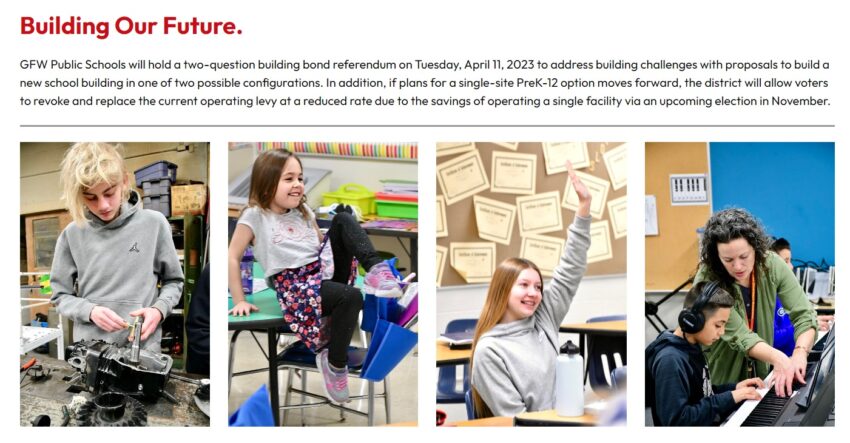Five Proven Strategies for Successful Bond Referendum Campaigns
[vc_row][vc_column css=”.vc_custom_1684353640447{margin-top: 0px !important;margin-bottom: -40px !important;}”][vc_column_text]
Is the idea of a bond referendum being thrown around in your district? Do you have no choice but to go to your community for a second or third time because the facility needs are not going away? It’s not too early to start planning. Here are five key strategies and how they were central to the success of three recent bond votes in April 2023.
1. Reach a Consensus on a Clear, Unified Vision
A vision helps promote clarity for the school’s community that can spark motivation and provide focus in all aspects of the referendum. The Superintendent and the School Board should reach a consensus in their support and be able to express this vision at all times. A unified vision for facilities should identify needs, explain priorities, and illustrate a progression of the next steps.
Jordan Public Schools placed a strong emphasis on “Pride in Facilities” within their strategic plan and clearly communicated securing referendum dollars as a benchmark within their community-driven, board-approved strategic plan. Consistency in this message created a strong foundation of trust and support leading up to the $34.9 million bond approval in April 2023.
Nevertheless, there are times when School Board members may not see eye to eye. In many cases, leveraging the results of a community-wide survey provides a clear direction for the School Board to reach a unified consensus. Making decisions based on survey results has proven time and time again to predict the success of a referendum.
2. Listen to Community Concerns
Many referendum-contingent projects can be high-profile and attract a great deal of attention and generate strong emotions. Providing opportunities for the community to raise concerns and identify priorities embeds transparency into the process. Opportunities such as:
[/vc_column_text][vc_separator][/vc_column][/vc_row][vc_row][vc_column width=”1/2″][vc_column_text]
- Developing a facilities steering committee made up of a representative group of community members who hold influence in different sectors of your community.
- Holding events such as town halls and community meetings to offer an open forum for community partners to ask questions and share feedback.
- Sending a community-wide survey to learn what the community is willing to support for project scope and tax impact (as mentioned in number 1 above).
- Building out a comprehensive and responsive FAQ page on your referendum website and funneling direct questions to your team of “experts” (e.g., construction managers, architects, engineers, finance and tax advisors, etc.).
[/vc_column_text][/vc_column][vc_column width=”1/2″ css=”.vc_custom_1684353609048{margin-top: -40px !important;}”][vc_single_image image=”29948″ img_size=”Full” alignment=”right”][/vc_column][/vc_row][vc_row][vc_column css=”.vc_custom_1684353582913{margin-top: -40px !important;}”][vc_column_text]
3. Focus on the Impacts and Benefits to Students
Referendum marketing materials designed around the current impacts and potential benefits to students, staff, and families are more apt to create a positive reaction. Student safety and Career and Technical Education Opportunities are themes that resonate well with voters.
The recent success of Gibbon-Fairfax-Winthrop’s $69.9 million referendum for a new Pre-K-12 facility has proven that running a student-centered campaign can win over divided communities. The campaign strategy, referendum logo, and tagline focused on “Building Foundations For Future Leaders” by outlining opportunities for a prepared workforce, a safe learning environment, future generations, and growth in fine arts and athletics.
[/vc_column_text][/vc_column][/vc_row][vc_row][vc_column width=”1/2″][vc_column_text]
4. Harness The Power of the Parent Vote
Parents of students and staff members as a segment of the District population can carry an election if the turnout is sufficient. This group should be fully informed about all aspects of the election and should play an active role in the election process. While the district has an obligation to inform the public at large, there should be a focus on shaping the campaign to engage those who are invested in the school system. A strong voter identification database will aid school districts with their identification of supporters, opponents, and those undecided who may need more information.
[/vc_column_text][/vc_column][vc_column width=”1/2″][vc_single_image image=”29950″ img_size=”Full” alignment=”right”][/vc_column][/vc_row][vc_row][vc_column css=”.vc_custom_1684353594931{margin-top: -40px !important;}”][vc_column_text]Don’t underestimate the power and influence of your parent and staff groups. In our experience, parents of school-aged children often forget to vote or run out of time. All three of our school district partners who found success this past April benefited from targeted plans to heavily inform, engage, and remind parents to vote, allowing them to get yes voters to the polls.
5. Create a Sense of Urgency
Creating a sense of urgency helps supportive voters see the need and recognize the importance of acting immediately. Often deficiencies in facilities, safety issues, cutting important programs due to space, and the belief the school is losing ground, helps voters understand how urgent the passage of the referendum has become.
People trust an urgent message coming from people they know. Marketing research indicates that text messages are read 98% of the time, compared to only 20% for email. With this in mind, we’ve placed added emphasis on text messaging in our referendum toolkit.
Set yourself up for future referendum success, by telling your District’s story now.
Building trust with your students, staff, and community takes time. Consistently telling positive stories and creating space for open dialog builds awareness for program and facility needs, which generates voter confidence prior to a bond referendum.
If you are looking for a trusted partner in pre-referendum and K-12 construction, we’d love to connect with you.
To stay up to date with current K-12 industry trends, subscribe to KAmpus Connection by clicking here.
By Jenna Mead, Director of Marketing and Referendum Planning
[/vc_column_text][/vc_column][/vc_row]
CATEGORY: Community Involvement
